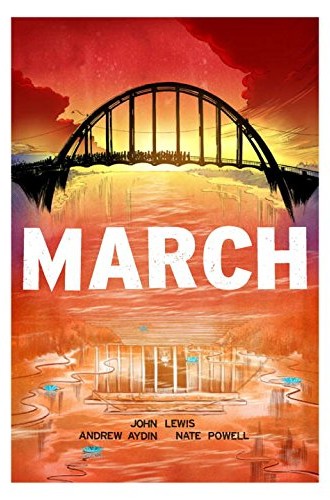In the face of violent white supremacy, how should I respond?
I was invited to an interfaith solidarity service. Instead I spent the day reading Congressman John Lewis's graphic novel trilogy about the civil rights movement.
It’s a hot day in August. A group of protesters gathers to demonstrate nonviolently against white supremacy. An iconic photograph is taken as the protesters kneel in prayer. A few minutes later, a vehicle deliberately plows into the group and strikes a young woman.
This scene, which occurred in Cairo, Illinois in 1962 during a protest outside of a racially segregated swimming pool, is depicted halfway through the second volume of March, the graphic novel trilogy co-written by John Lewis and Andrew Aydin and illustrated by Nate Powell.
I had a lot to do when I came into the office this morning, but my eye kept veering toward the trilogy, which had been sitting on my desk for a few days. Given the hatred-driven violence this weekend in Charlottesville—and my inability to know how to respond as a white progressive Christian who both denounces white supremacy and benefits from it—I figured the least I could do was to glance at the first few pages of March, if for no other reason than to brush up on my knowledge of the history of the civil rights movement.
Graphic novels aren’t my favorite genre, but I was quickly drawn into the first volume’s juxtaposition of the inauguration of Barack Obama with Lewis’s recollections of his early years. As a child, Lewis imagined himself to be a preacher as he cared for his family’s flock of chickens. He preached to the chickens and even baptized them. He also learned from them about fair treatment and violence, the vulnerability of bodies and the value of a life, and the realities of sacrifice and death. I kept reading.
Before I knew it, several hours had passed and I had read all three books in one sitting. I didn’t even get up from my desk to refill my coffee cup as I read. But my hands were shaking from adrenaline as I read the series, so the absence of additional caffeine was probably for the best. That adrenaline may have come purely from the content of the books, which graphically (in both senses of the word) portray the violence that occurred at the Nashville restaurant sit-ins, the Freedom Rides, the Sixteenth Street Baptist Church in Birmingham, the voter registration movement, and the Selma marches.
But I suspect my shaking hands also had to do with the resonances between Lewis’s recollections of violence and the recent heightened public legitimacy of white supremacy in America, which has become even more prominent since this trilogy was released in September 2016. “His consistent preaching of defiance of the law, his vitriolic public pronouncements, and his irresponsible actions have created the atmosphere in which violence could thrive,” proclaims Martin Luther King Jr. in the second volume of the trilogy. King is speaking about Alabama governor George Patterson in May of 1961, but the same words might be said of the current U.S. president, whose lackluster response to the Charlottesville attack has been taken by many white supremacy groups as an implicit endorsement.
“American politics is dominated by politicians who build their careers on immoral compromises, and ally themselves with open forms of political, economic, and social exploitation,” says Lewis at the March on Washington at the end of the second volume. But as much as I want to blame those with political power, the March trilogy’s greatest challenge to me was to make me question my own role and responsibilities in the unfolding narrative of white supremacy in our country.
“In our country we have some real evil, and the attempt to do something about it involves enormous effort . . . and therefore, tremendous risks,” says the Mississippi voting rights activist Bob Moses in the third volume. What risks might God be calling Christians to take in today’s worrisome cultural and political climate? How do the risks that were taken by the leaders of the civil rights movement in the sixties change the meaning of risk taken by protestors today? How do skin color, economic status, gender identity, and faith tradition change the calculus of risk for a given person who seeks to work against violence?
I’m aware that while I was at my desk reading about the civil rights movement, a few blocks away interfaith leaders were gathering in the public square for an interfaith solidarity service. They were on the streets using their bodies; I was using only my mind. I’m also aware that most people would probably be fired if their boss found out that they spent most of a workday reading and writing about 560 pages of comic books. There’s no risk for me in doing so. Reading a book is safe. Acting on what I’ve read is the more difficult—and more crucial—calling.






